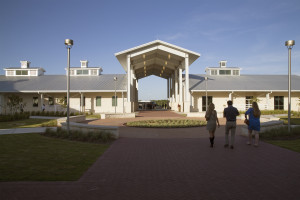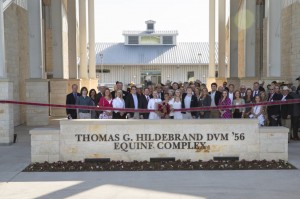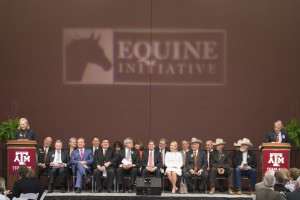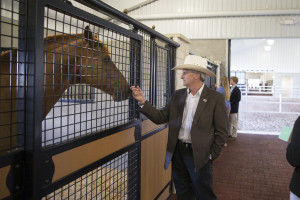Grand Opening of New Texas A&M $32 Million Equine Complex
Texas A&M University
COLLEGE STATION, Texas – Texas A&M celebrated the grand opening of the Thomas G. Hildebrand, DVM ’56 Equine Complex. This $32 million dollar facility is the first phase of a planned $80 million dollar project of the Equine Initiative.
The equine complex was named in honor of Thomas G. Hildebrand, DVM ’56 to recognize his contributions to the field of veterinary medicine and his love for Texas A&M. The new complex represents one of the core efforts of the Texas A&M Equine Initiative, which was formed to bring together equine research, teaching, extension, and outreach in the Texas A&M College of Agriculture & Life Sciences and the College of Veterinary Medicine & Biomedical Sciences (CVM).
“This new facility solidifies Texas A&M University’s position as a national leader in equine programs—in equine sciences and veterinary medicine,” said Eleanor Green, the Carl B. King Dean of Veterinary Medicine. “The considerable support from current leaders in the equine industry, all friends of Texas A&M, clearly indicate the importance of our university serving the significant equine industry, locally to globally. This premier facility will help us not only serve but also significantly impact the future of the industry. In addition, this state-of-the-art facility honors Dr. Hildebrand, one of the revered graduates of the College of Veterinary Medicine & Biomedical Sciences.”
“This facility provides an outstanding home for the work of our two colleges and the Texas A&M AgriLife agencies. Together, we are raising the profile of equine sciences across Texas,” said Bill Dugas, acting vice chancellor and dean for agriculture and life sciences. The new complex brings together academic and non-academic departments, industry partners, and a vast array of equine professionals in a unique collaborative and innovative environment. “This equine complex will help develop future leaders for the equine industry, as well as provide a new home for some well-known Aggie traditions,” Dugas said.
The complex provides support for teaching, research, extension, and outreach initiatives dedicated to equine programs. These premier facilities will also positively influence the recruitment and retention of the best faculty and students. This environment better equips faculty and students to perform at their best, resulting in an equine program that will foster the development of equine academic leaders and graduate the industry’s future leaders in equine sciences and veterinary medicine.
“We are thankful for the partnership of the College of Agriculture and Life Sciences, the College of Veterinary Medicine & Biomedical Sciences, Texas A&M Athletics, and the equine industry for making this vision a reality,” said Jim Heird, executive professor and coordinator of the Equine Initiative. “Together we can not only advance new knowledge for the benefit of horses and horse owners, but also enhance Texas A&M’s rich equine traditions.”














